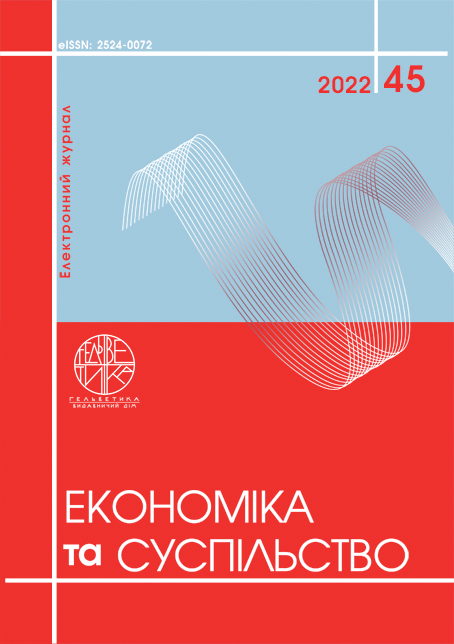RISK ASSESSMENT OF THE ANTI-MONEY LAUNDERING AND CYBER SECURITY SYSTEMS’ CONVERGENCE
Abstract
The growth of financial and cyber threats leads to the most significant losses in the financial sector. Only complex approaches can be the most effective to counteract them, which require processes of systems' convergence of financial monitoring and cyber security. Therefore, this article is devoted to determining the convergence risk for different countries. The study proposes a scientific and methodological approach to its evaluation, which involves implementing four stages. The empirical database was formed by the National Cyber Security Index and the Anti-Money Laundering Index for 114 countries in 2022. The first index characterizes the level of development of the country's cyber security system. The second indicator reflects the degree of criminal proceeds legalization risk. Calculations were made using the Python programming language. In the first stage, countries were clustered according to the money laundering risk performed using such methods as "Silhouette analysis" and "K-means" clustering. As a result, seven clusters were obtained, which make it possible to identify countries by the possibilities of criminal income legalization. In the second stage, a similar procedure was carried out to obtain countries' segments regarding the level of their cyber security. As a result, six clusters were obtained, which allowed identifying the level of development of the cyber threat countermeasure system. An integral convergence index was proposed and calculated in the third stage using normalization and geometric mean methods. Based on the cluster analysis results, nine risk groups of the systems' convergence for countering financial and cyber risks were determined for different countries. The fourth stage was devoted to developing a predictive model of convergence risk based on a classification decision tree. The quality of the model turned out to be high, although, for the second classification group, the model will not be able to make the correct prediction. The proposed approach is of practical importance for improving countries' strategies for combating financial and cybercrimes.
References
Eling, M. & Schnell, W. (2016). What do we know about cyber risk and cyber risk insurance? The Journal of Risk Finance, 17(5), 474–491. DOI: https://doi.org/10.1108/JRF-09-2016-0122.
Eisenbach, T. M., Kovner, A. & Lee, M. J. (2022). Cyber risk and the U.S. financial system: A pre-mortem analysis. Journal of Financial Economics, 145(3), 802–826. DOI: https://doi.org/10.1016/j.jfineco.2021.10.007
Gatzert, N. & Schubert, M. (2022). Cyber risk management in the US banking and insurance industry: A textual and empirical analysis of determinants and value. Journal of Risk and Insurance, 89(3), 725–763. DOI: https://doi.org/10.1111/jori.12381
Kozhedub, Yu. (2017). Analiz dokumentiv z keruvannia ryzykom kiberbezpeky [Analysis of cybersecurity risk management documents]. Information Technology and Security, 5(1), 82–95. [in Ukrainian]
Fabris, N. (2022). Impact of Covid-19 Pandemic on Financial Innovation, Cashless Society, and Cyber Risk. ECONOMICS, 10(1), 73–86. DOI: https://doi.org/10.2478/eoik-2022-0002
Vučinić, M. & Luburić, R. (2022). Fintech, Risk-Based Thinking and Cyber Risk. Journal of Central Banking Theory and Practice, 11(2), 27–53. DOI: https://doi.org/10.2478/jcbtp-2022-0012
Uddin, M. H., Ali, M. H. & Hassan, M. K. (2020). Cybersecurity hazards and financial system vulnerability: a synthesis of literature. Risk Management, 22(4), 239–309. DOI: https://doi.org/10.1057/s41283-020-00063-2
Grody, A. D. (2020). Addressing cyber risk in financial institutions and in the financial system. Journal of Risk Management in Financial Institutions, 13(2), 155–162.
Institute of Risk Management (2022). Institute of Risk Management - expert Risk Predictions 2018 and the Risk Agenda 2025. Retrieved from: https://www.theirm.org/news/institute-of-risk-management-expert-risk-predictions-2018-and-the-risk-agenda-2025/.
Basel AML Index (2022). Basel AML Index. Assessing Money Laundering Risks Around The World. Retrieved from: https://index.baselgovernance.org/.
Haro G. Shape from silhouette consensus and photo-consistency. Retrieved from: https://repositori.upf.edu/bitstream/handle/10230/35708/haro_ icip14_shape.pdf;jsessionid=21B7F0CD85AB9435B87CD7AB8D338316?sequence=1.
E-Governance Academy (2022). National Cybersecurity Index. Retrieved from: URL: https://ncsi.ega.ee/.


